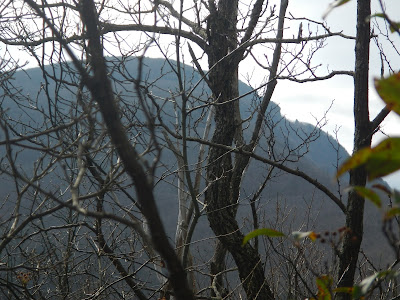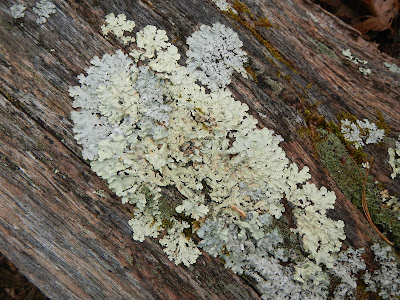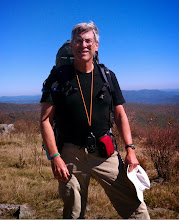I thought I'd share a little about a few mountain hikes to wrap up the year. The first of these I had already written a little about with my journal entry about the "Lazarus Woodpeckers." This hike was on November 21 at the Corbin Cabin Loop in the Central Part of Shenandoah National Park, which is only about 4 miles but with over 1,200 feet of elevation descent and ascent. It goes down steeply from the Skyline Drive to the Hughes River. You cross the river, go by the cabin, and then ascend continually back to the Skyline Drive. The last little bit back to the car is along the Appalachian Trail.
With COVID pandemic, people are flocking to the outdoors. This hike is not even that popular, yet look at the trailhead parking. I had tried to do this as a last minute group hike, but no one else wanted to go. Good thing, because I was challenged to find a spot for just my car. With the pandemic, we no longer car pool on hikes.
It was at this spot that I saw the "dead" woodpeckers that I had posted about. The cabin had a couple camping out there, and they had a smoky fire going. It would be fun to do sometime with a group, post-pandemic.
This is a view up the Hughes River as I was crossing it.
On the hike back up, I had a decent view of Stony Man, where I have hiked to a couple of times, mostly with the
Road Scholar hiking groups that I led in 2019.
Life in incredible. This lichen, a combination of at least three living things that can only survive together, just lives its life and survives in all weather conditions, oblivious to all of humankind's political strife and so forth.
My next two hikes were on December 2. The first of these was with a group, and we hiked a pretty new trail, the Blue Ridge Tunnel Trail. This trail goes along a former railway line through a nearly mile long tunnel built in the mid-19th century by impoverished Irish immigrants who were fleeing the Potato Famine. Many of them died doing this difficult, backbreaking, and dangerous work. The hike is an out and back, and totals about 4.5 miles. It's mostly flat, with one long climb at the end before turning around and repeating it.
Here is the approach to the tunnel. There is an active railway line to the left, so a high fence keeps people away from it.
Nearing the tunnel entrance:
In the tunnel. It's almost pitch black inside, but I was able to mostly walk without a light because the floor is (mostly) level and rut-free.
The light at the end of the tunnel.
There are several interpretive signs along this hike with interesting information about the history of the tunnel and its construction. A nearby town, Crozet, is named after the engineer who designed it.
Near an entrance, water cascades down the rocks.
Here is a shot of returning to the tunnel entrance where we started.
After leaving the group at the conclusion to this hike, I drove into nearby Shenandoah National Park, drove to Beagles Gap, and hiked the Bear Den Fire Road. I had hiked most of it a couple of years ago, but had a final four tenths of a mile to hike. It was cold and windy with some ice patches along the way. I took a tumble and landed on my butt when I slipped on one of them near the start of the hike. The hike is about 1.8 miles long with 950 feet of descent. It goes through rugged mountain terrain.
The reason that I hadn't finished this trail when I hiked it before was because of two stream crossings. I had not wanted to soak my boots. This time, I brought my river shoes, although the cold water in December was miserable as I crossed the stream twice going down and twice coming back.
At the end of the trail, one reaches the park boundary and turns back for the 1.8 mile, 950 foot climb back to Beagle Gap.
After crossing the cold streams, I dried my feet with my fleece, put my boots on, and hiked back along the fire road.
Here is a view of the Shenandoah Valley from Beagles Gap. It was cold and windy. I ate my peanut butter sandwich in the car and starting drinking my piping hot mug of tea before heading for home after getting in two great hikes.
I did hike in the mountains one last time in 2020 after these hikes. But this post is long enough, so I will write separately about that fun hike past the Black Rocks.














































